Blade Runner 4K Blu-ray Movie
HomeBlade Runner 4K Blu-ray Movie 
The Final Cut / 4K Ultra HD + Blu-ray + UV Digital CopyWarner Bros. | 1982 | 118 min | Rated R | Sep 05, 2017
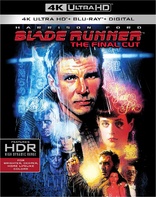
Movie rating
8.7 | / 10 |
Blu-ray rating
| Users | 4.5 | |
| Reviewer | 4.5 | |
| Overall | 4.5 |
Overview
Blade Runner 4K (1982)
In a future of high-tech possibility soured by urban and social decay, a 21st-century detective is on the trail of four fugitive replicants—cloned humans that are now illegal—and is drawn to a mystery woman whose secrets may undermine his soul.
Starring: Harrison Ford, Rutger Hauer, Sean Young, Edward James Olmos, M. Emmet WalshNarrator: Harrison Ford
Director: Ridley Scott
| Sci-Fi | Uncertain |
| Epic | Uncertain |
| Thriller | Uncertain |
| Drama | Uncertain |
| Film-Noir | Uncertain |
Specifications
Video
Video codec: HEVC / H.265
Video resolution: 4K (2160p)
Aspect ratio: 2.40:1
Original aspect ratio: 2.39:1
Audio
English: Dolby Atmos
English: Dolby TrueHD 7.1 (48kHz, 24-bit)
French: Dolby Digital 5.1 (640 kbps)
German: Dolby Digital 5.1 (640 kbps)
Italian: Dolby Digital 5.1 (640 kbps)
Spanish: Dolby Digital 5.1 (640 kbps)
Spanish: Dolby Digital 2.0 (192 kbps)
Portuguese: Dolby Digital 5.1
Czech: Dolby Digital 5.1
Polish: Dolby Digital 5.1 (640 kbps)
Russian: Dolby Digital 5.1
Japanese: Dolby Digital 2.0 (192 kbps)
Spanish 5.1=Castilian; 2.0=Latin
Subtitles
English SDH, French, German SDH, Italian SDH, Japanese, Portuguese, Spanish, Arabic, Cantonese, Czech, Danish, Dutch, Finnish, Hebrew, Korean, Mandarin (Simplified), Mandarin (Traditional), Norwegian, Polish, Russian, Swedish, Turkish
Discs
Blu-ray Disc
Four-disc set (2 BDs, 2 DVDs)
UV digital copy
4K Ultra HD
Packaging
Slipcover in original pressing
Playback
Region free
Review
Rating summary
| Movie | 5.0 | |
| Video | 2.0 | |
| Audio | 5.0 | |
| Extras | 2.5 | |
| Overall | 4.5 |
Blade Runner 4K Blu-ray Movie Review
"I've Seen Things You People Wouldn't Believe"
Reviewed by Michael Reuben August 30, 2017Ridley Scott's Blade Runner has a long and colorful history that includes production turmoil, box
office failure, multiple versions and a dawning awareness that the film is a masterpiece. As Blade
Runner has progressed from cult classic to cinematic landmark, its ever-expanding fan base has
sustained a small industry of books, articles and documentaries, and its impact has permeated the
culture. One would be hard-pressed to identify any other futurist fantasia (with the possible
exception of Fritz Lang's Metropolis
) that has exercised
so much influence on the imaginations of succeeding generations of filmmakers.
In 2007, after numerous versions of Blade Runner had already appeared, Warner Brothers
released the Final Cut, which is Ridley Scott's preferred version of the film (though not
necessarily the preferred version of every fan). The Final Cut includes every narrative adjustment
that Scott contemplated over the years, and it fixes numerous mistakes that resulted from rushed
production and a tumultuous post-production besieged by conflict and financial pressures. The
Final Cut didn't satisfy everyone, and it may not even be the best version for a first-time viewer
to experience, but it's a remarkable achievement that finally brought the film's lengthy evolution
to a close.
The Final Cut was initially released on Blu-ray in an exhaustively thorough 5-disc collection that
included four prior versions accompanied by a wealth
of informative extras. That same collection was re-issued in 2012 for the film's thirtieth
anniversary, with the material reconfigured to reside on three discs. Now Warner is adding Blade
Runner to its 4K catalog, with a new UHD disc accompanied by some (but only some) of the
previously released material. The 4K disc is magnificent. The collection accompanying it is a
botch job.
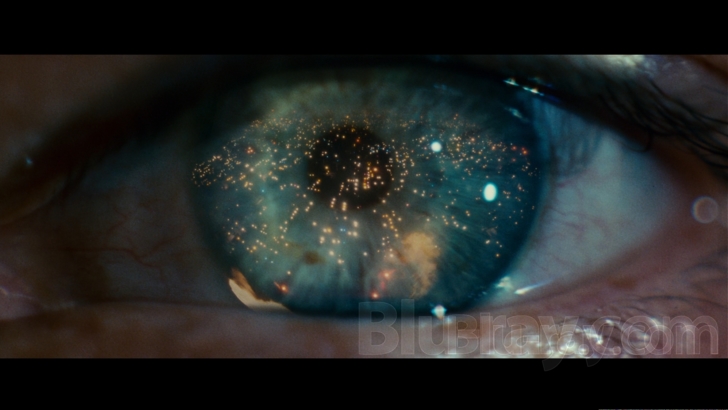
Blade Runner has been extensively discussed in multiple venues over the last 35 years. Blu-ray.com's original review of the 2007 release can be found here. Having watched the film innumerable times, in a wide array of formats beginning with a theatrical viewing in 1982, I found myself struck this time by how differently the future has turned out from what Scott and his designers imagined. They were certainly aware of the imminent digital revolution, but much of what they designed has an endearingly retro style that is analog, organic and even clunky. Their approach has allowed Blade Runner to avoid a common fate of much futuristic cinema, which is to grow dated with the passage of time. Blade Runner is set in 2019, and no matter what happens between now and then, the future will never resemble the rainy streets and soaring towers of Rick Deckard's Los Angeles—but it doesn't matter. The film exists in a parallel universe all its own, where events unfold with the instinctive logic of a dream and mysterious forces hover around the edge of the frame, always unseen and with purposes unknown. Originally conceived as a dystopian vision, Blade Runner has evolved into a seductive nightmare from which you don't want to awake.
Blade Runner 4K Blu-ray Movie, Video Quality 
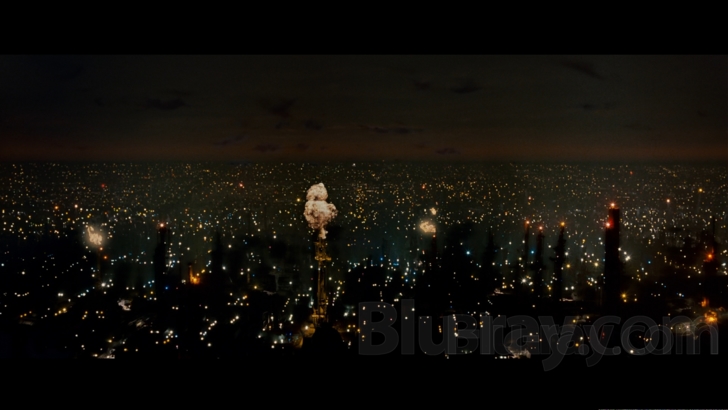
(Note: Screenshots accompanying this review have been captured from the standard Blu-ray.
Additional captures from that disc can be found here.)
The Final Cut of Blade Runner was assembled from multiple sources, including a high-resolution
scan of the film's original camera negative as well as new effects originated and completed
entirely in the digital domain. The final result was a 4K digital intermediate that was used as a
source for the 2007 Blu-ray. For this
new 2160p,
HEVC/H.265-encoded UHD, Warner has
returned to that 4K DI, with no further modifications other than the application of HDR
encoding.
Unfortunately, the studio has decided not to accompany the 4K disc with a remastered 1080p
Blu-ray, as it did with its recent UHD release of Unforgiven. The 2007 Blu-ray is a low-bitrate
VC-1 encode prepared for both Blu-ray and HD-DVD, and its age is showing. The Final Cut
could look much better on Blu-ray than it did ten years ago. By failing to provide a remastered
standard disc, Warner has missed an opportunity to sell this set to fans who haven't yet upgraded
their equipment to 4K but would be willing to "future proof" their purchase for the sake of an
improved 1080p experience.
Compared to the dated Blu-ray, Blade Runner's UHD presentation can't help but look better, but
it's more than better—it's astonishing. The improvements begin with the opening logos, where
the pixelated tree representing the Ladd Company unfurls across and down the screen without a
hint of the flicker and aliasing that have been there on every prior version, including the 2007
Final Cut Blu-ray. The opening aerial views of 2019 Los Angeles have always been impressive,
but prepare to gasp when the Tyrell Building comes into view, with each window, level and
outcropping now sharply and crisply resolved. (The Blu-ray is blurry by comparison.)
Throughout the film, the UHD's resolution reveals so much detail in the remarkable model work
that it almost breaks the illusion of scale. If the cityscape were any clearer, you'd see that it was
made of miniatures.
The combination of 4K resolution and HDR encoding highlights numerous fine details that have
been there all along but now command new attention. I never before focused on the crisply
stenciled "Tyrell Corp." on the chairs in which Leon and Holden sit during their fateful
encounter, but now that logo is sharply visible. The textured vertical striping on the bow tie worn
by Dr. Tyrell during his meeting with Deckard rises out of the frame, adding yet one more item to
the genius tycoon's list of sartorial eccentricities. The individual strands on Rachel's oversized
fur coats stand out vividly, making both the coats and their wearer seem even more out of place.
(Who wears huge fur coats when it's always raining?) Individual stars in the sky above Batty as
he descends from his meeting with Tyrell blaze more brightly, and more of them are visible. In
the scene where J.F. Sebastian sits at his dining room table surrounded by his family of
genetically engineered toys, more of Sebastian's odd creations can be seen clearly, even those at
the edges of the frame, expanding the group of onlookers who will watch helplessly as Pris and
Batty enter and Sebastian begins to grasp his dangerous predicament.
Warner's UHD of the Final Cut brings some of the most influential visuals in movie history to
the home theater screen with a focus and intensity unmatched by any but the finest theatrical
presentations. It's one of the handful of discs to date that truly delivers on the promises of 4K.
Watching Blade Runner on this disc is like seeing the film anew. Everything you remember
seeing is there—and more.
[System calibrated using a Klein K10-A Colorimeter with a custom profile created with a
Colorimetry Research CR250 Spectraradiometer, powered by SpectraCal CalMAN 2016 5.7,
using the Samsung Reference 2016 UHD HDR Blu-ray test disc authored by Florian Friedrich
from AV Top in Munich, Germany. Calibration performed by Kevin Miller of ISFTV.]
Note: 2K score updated to reflect clarifications to scoring categories since this review was first published.
Blade Runner 4K Blu-ray Movie, Audio Quality 
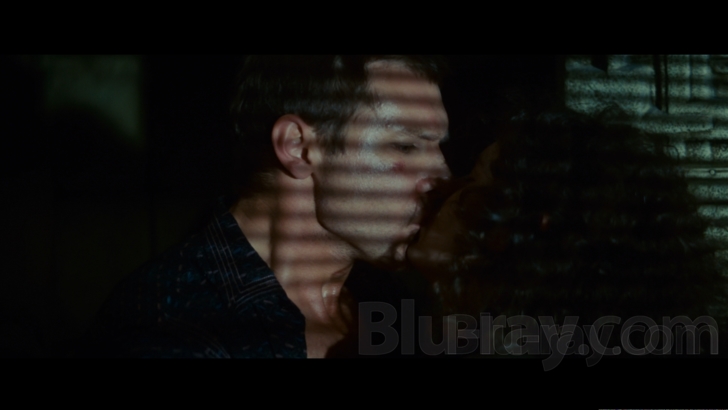
Almost as impressive as the visual upgrade is the newly remixed Dolby Atmos soundtrack. I
didn't think it was possible to improve on the effective 5.1 mix supplied on the 2007 Blu-ray in
Dolby TrueHD, but the sound engineers have achieved new levels of intensity and immersion. The
opening drumbeats of Vangelis' electronic score are thunderous and deep while remaining tightly
focused. The score and sound effects have been blended and intertwined more closely than ever
to create a uniquely eerie audio landscape. Background dialogue like the loudspeaker voice at the
Tyrell Corporation (during Leon's interview) and the announcements from the ever-present
dirigible advertising life in the off-world colonies are more distinct, while retaining their
appropriate place in the background. Continuous rainfall fills the room during outdoor scenes
such as Deckard's introduction, while individual effects like the flashing neon dragon's tongue at
the noodle stand remain clearly localized, as does the dialogue. The hubbub of large crowd
scenes like those at Taffey Lewis' club or the busy streets where Deckard pursues Zhora is both
expanded and refined, so that you have the sense of being surrounded by a sea of individual
voices rather than a generalized murmur. The sounds of the Bradbury Building (pigeons flapping
their wings, elevators rising and descending, water streaming) are intensified and precisely
placed.
One could continue noting examples for pages, but the point is that the Final Cut's UHD doesn't
just feature a superior picture; it also offers a quantum leap in audio quality, drawing the viewer
further into Rick Deckard's darkly mysterious world and making Blade Runner live and breathe
even more vibrantly on the screen. For those with the equipment to decode it, the Atmos track
alone would justify an upgrade (which makes it doubly unfortunate that Warner has chosen not to provide a remastered
standard Blu-ray).
Blade Runner 4K Blu-ray Movie, Special Features and Extras 
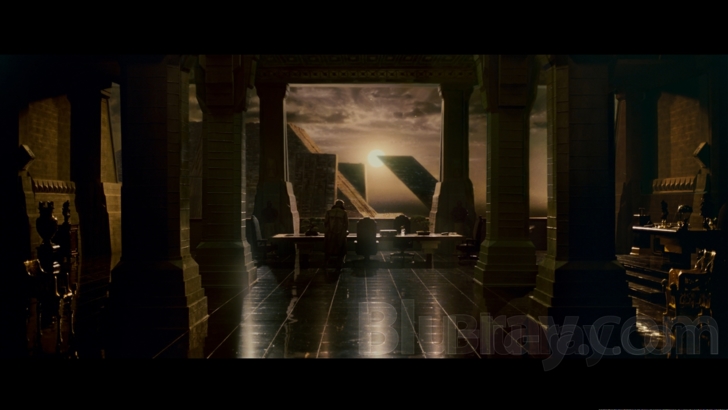
The selection of extras included in this package has been the source of major confusion, and
Warner is almost entirely to blame. First, the press release for this set was less than a model of
clarity. Second, when screeners were sent to reviewers several weeks before street date, the
contents of the package didn't match what was listed in the press release (and we now know that the same mistake affects
some, but not all,
retail copies; see "Update" below). Third, and most importantly, the selection of extras for this set is nonsensical, omitting
key features that are
essential to an understanding of the history leading to the Final Cut of Blade Runner.
Here's the short version: There is one, and only one, extra that is new to this set and unavailable
with any other edition. That is the trailer for the Final Cut, which has been
remastered in 4K and HDR and appears on the UHD disc. Nothing else is new, but many things
have been dropped.
The UHD disc contains the same extras included on the Final Cut Blu-ray in the 5-disc Blade
Runner 2007 edition, i.e., three separate commentaries and an introduction to the Final Cut (in 1080p)
recorded by Ridley Scott in 2007. Warner has chosen to accompany the UHD disc
with three of the five discs from the 2007 edition. They are listed below by their designations in
the original set:
- Disc 1: The Final Cut in standard Blu-ray. Note that this is the same disc released in 2007 on both Blu-ray and HD-DVD. It's a VC-1 encode on a BD-25. It contains the same commentaries and director's introduction as the UHD.
- Disc 2: The DVD containing the excellent "Dangerous Days" documentary. As with the Final Cut in standard Blu-ray, this disc is simply a reprint of what was released in 2007.
- Disc 4: A second DVD containing a collection of featurettes, trailers, deleted and alternate scenes and other supporting material. A complete list can be found here. Again, this disc is simply a reprint from 2007.
Omitted from the UHD set are discs 3 and 5 of the original 2007 set. Both were Blu-rays. Disc 3 held three previous cuts of Blade Runner, including the 1982 theatrical release in both domestic and international versions. Disc 5 held the so-called "Workprint", the discovery of which generated a new interest in Blade Runner's history. A commentary by Blade Runner expert Paul Sammon accompanied the Workprint. Disc 5 also contained a documentary entitled "All Our Variant Futures: From Workprint to Final Cut", which is an essential guide to how the Final Cut was created.
Why were some features kept and others dropped? Warner has offered various explanations, but none of them stands up to scrutiny. The main justification is that the UHD package is focused on the Final Cut, but if that's the case, why omit "All Our Variant Futures", which is a detailed account of how the Final Cut was prepared? The documentary follows the team that sorted through Blade Runner's stacks of stored negative, trims and outtakes to locate all the essential materials; shows actress Joanna Cassidy filming new inserts for the effects team to use in correcting major flaws in a key sequence; and includes Harrison Ford's son, Ben, who in 2007 was the same age as his father when he played Deckard and was recruited to loop some of his father's lines. Any release that purports to focus on the Final Cut is woefully incomplete without this documentary.
And how can one claim that the UHD package is focused on the Final Cut when it includes over seven hours of extras (on DVD) devoted to Blade Runner's long history of previous versions? Anyone who truly understands and cares about the film should know that there can be no dividing line between Final Cut and non-Final Cut extras. The collection of extras assembled in 2007 documented a rich and continuous history, and all of them should have been provided.
The simplest and most likely explanation is that the UHD team that assembled this package has little or no understanding of the film they're releasing. Indeed, the team does not even seem to have been familiar with their own company's prior Blu-ray releases. They were apparently unaware that, for the film's thirtieth anniversary in 2012, Warner released a special edition in which all of the previously released extras were consolidated onto a single Blu-ray disc, which also included a remastered version of the Workprint (with commentary) and an all-new photo gallery. If the UHD team had simply reprinted that disc, instead of the two DVDs, they could have equipped their package with a full complement of extras and probably cut costs in the bargain. But first they'd have to be aware of the 2012 disc's existence. Apparently, like the film's unfortunate Hannibal Chew, they "don't know such stuff".
Now bear with me, please, because here's where the story gets even more twisted. Consistent with the putative focus on the Final Cut, the UHD set was not supposed to include the 2007 set's disc 3, with three earlier versions of the film. But when reviewers opened their screeners sent in advance of release, they discovered that disc 3 had indeed been included, while disc 4, which was supposed to be a DVD with extras, had been dropped. Warner has announced that this is an error, which should be corrected by the time retailers receive final product. In the meantime, though, the mistake has provoked both confusion among fans and renewed scrutiny of the UHD team's inexplicable omissions from the set. (See, for example, the discussion in Blu-ray.com's UHD forum.)
The bottom line is that, with respect to extras, this edition of Blade Runner adds nothing of consequence, while at the same time making crucial subtractions that are both unnecessary and unjustified. The review score for extras has been lowered accordingly, along with the overall score.
UPDATE on Sept. 5, 2017: Reports from early recipients indicate that, contrary to Warner's assurance, the error in review screeners was not corrected before street date. Retail copies from Amazon and Best Buy contain the same incorrect set of discs sent to reviewers. We await further word from Warner.
UPDATE on Oct. 6, 2017: Although there has been no official announcement from Warner, purchasers who received the incorrect set of discs have reported that they have been able to obtain the Enhancement Archive DVD through the studio's customer service portal.
Blade Runner 4K Blu-ray Movie, Overall Score and Recommendation 

The 4K disc of Blade Runner is a thing of beauty, but the set with which it arrives is something
else: ill-conceived, poorly executed and to all appearances designed by people who have no
understanding of the film or its provenance. Especially egregious is the failure to remaster the
standard Blu-ray from 2007, which is dated and inferior. My advice is to forget about the crippled
selection of accompanying discs and features and evaluate the purchase as if it were a single 4K
disc. Anyone who wants a complete set of features and versions representing
the full history of Blade Runner will need to acquire the 5-disc 2007 set (which has been
discontinued) or the 30th Anniversary edition
(also, apparently, discontinued). Solely on the merits of the 4K disc, the UHD is
recommended. For the rest, the team in charge of this collection should be ashamed of
themselves.
Other editions
Blade Runner: Other Editions

Blade Runner
The Final Cut
1982

Blade Runner
The Final Cut
1982

Blade Runner
30th Anniversary Edition
1982

Blade Runner
30th Anniversary Collector's Edition
1982

Blade Runner
Ultimate Collector's Edition
1982

Blade Runner
30th Anniversary Collector's Edition
1982

Blade Runner
The Final Cut
1982

Blade Runner
5-Disc Complete Collector's Edition
1982
Similar titles
Similar titles you might also like

Blade Runner 2049 4K
2017

The Day the Earth Stood Still
Special Edition
1951

Gattaca 4K
Limited Edition / Reprint
1997

The Day the Earth Stood Still
2008

Close Encounters of the Third Kind 4K
40th Anniversary Edition
1977

Elysium 4K
2013

Arrival 4K
2016

Dark City
Director's Cut
1998

Ex Machina 4K
2015

V: The Complete Second Season
2011

Contact
1997

THX 1138
The George Lucas Director's Cut
1971

Forbidden Planet
Includes "The Invisible Boy" on SD
1956

A Quiet Place
2018

Extant: The First Season
2014

Helix: The Complete First Season
2013

Childhood's End
2015

Impostor
2001

The Prestige 4K
2006

Fringe: The Complete Series
2008-2013